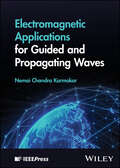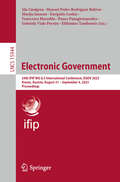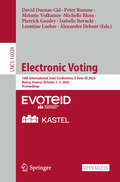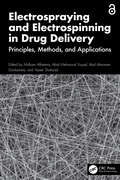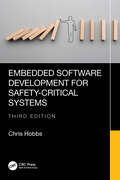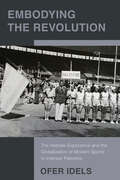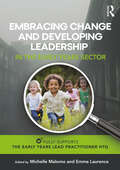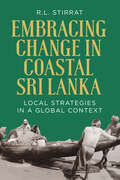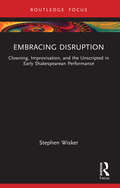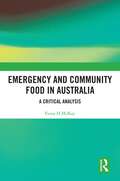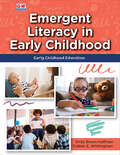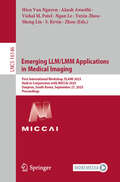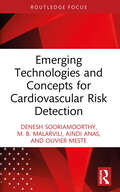- Table View
- List View
Electromagnetic Applications for Guided and Propagating Waves
by Nemai Chandra KarmakarEnables readers to grasp the fundamentals of applied electromagnetics through a blended pedagogical approach Electromagnetic Applications for Guided and Propagating Waves comprehensively covers both fundamentals and advanced topics in applied electromagnetics (EM) for the professional, going above the basic static and dynamic EM field theories that are covered in most undergraduate EM textbooks. The textbook introduces complex topics with illustrations of modern technologies that use the topics, followed by a simple presentation of the basic vector analysis and Maxwell’s equations, supported by many practical examples, math essays, math puzzles, and the most modern technological developments from the websites of prominent technology companies. The textbook includes review questions at the end of each topic to enhance the students’ learning experience and outcomes. It provides the links for multimedia lecture videos and directs students to relevant open sources such as YouTube videos and lecture materials from the prestigious universities of developed and developing nations. The textbook is supported by presentation slides, a solution and instructor’s manual, and MATLAB program downloads. Written by prolific teacher Dr. Karmakar, Electromagnetic Applications for Guided and Propagating Waves discusses topics including: Fundamental theories of resonators, optical waveguides and fibers, antennas and antenna arrays, wireless systems, and electromagnetic compatibility Electrostatic field theory and detailed derivations of electromagnetic fundamentals such as electric charges and Coulomb’s law Applications of time-varying electromagnetic fields, covering transmission lines, impedance matching techniques, and waveguides How electromagnetics has impacted our day-to-day life and how we use it in our workplace and on social media Historical anecdotes and evolution of EM theory from its inception to Maxwell and Hertz Electromagnetic Applications for Guided and Propagating Waves is an essential reference for researchers, professionals, and policy and decision makers in the fields of electromagnetics, electrical engineering, wireless communications, and defense.
Electronic Government and the Information Systems Perspective: 14th International Conference, EGOVIS 2025, Bangkok, Thailand, August 25–27, 2025, Proceedings (Lecture Notes in Computer Science #16049)
by Andrea Kő Ismail Khalil A Min Tjoa Francesco Buccafurri Gabriele KotsisThis book constitutes the proceedings of the 14th International Conference on Electronic Government and the Information Systems Perspective, EGOVIS 2025, held in Bangkok, Thailand, during August 25–27, 2025. The 11 full and 4 short papers included in the proceedings were carefully reviewed and selected from 29 submissions. They were organized in topical sections as follows: Legal Aspects and Semantic Approaches; Digital Transformation and E-government Inclusion; AI in E-Government; E-Government Cases.
Electronic Government: 24th IFIP WG 8.5 International Conference, EGOV 2025, Krems, Austria, August 31 – September 4, 2025, Proceedings (Lecture Notes in Computer Science #15944)
by Efthimios Tambouris Panos Panagiotopoulos Marijn Janssen Ida Lindgren Manuel Pedro Rodríguez Bolívar Gabriela Viale Pereira Euripidis Loukis Francesco MuredduThis LNCS conference set constitutes the proceedings of the 24th IFIP WG 8.5 International Conference on Electronic Government, EGOV 2025, in Krems, Austria, held during August 31–September 4, 2025. The 25 full papers presented were carefully selected from 116 submissions. They were categorized under the topical sections as follows: E-Government and E-Governance; Emerging Issues and Innovations; Open Data; Smart Cities; AI, Data Analytics and Automated Decision-Making.
Electronic Participation: 17th IFIP WG 8.5 International Conference, ePart 2025, Krems, Austria, August 31–September 4, 2025, Proceedings (Lecture Notes in Computer Science #15978)
by Sara Hofmann Peter Parycek Gerhard Schwabe Jolien Ubacht Lieselot Danneels Anna-Sophie Novak Roel Dobbe Vera SpitzerThis book constitutes the refereed proceedings of the 17th IFIP WG 8.5 International Conference on Electronic Participation, ePart 2025, held in Krems, Austria, during August 31–September 4, 2025. The 21 full papers included in this book were carefully reviewed and selected from 116 submissions.The papers were organized in topical sections as follows: Foundations and Frameworks of eParticipation; AI and Algorithmic Systems in Public Administration; Governance, Collaboration, and Policy Alignment; Local Practices, Implementation, and Innovation; Digital Services, Usability, and Citizen Interaction.
Electronic Voting: 10th International Joint Conference, E-Vote-ID 2025, Nancy, France, October 1–3, 2025, Proceedings (Lecture Notes in Computer Science #16028)
by Melanie Volkamer David Duenas-Cid Isabelle Borucki Peter Roenne Michelle Blom Pierrick Gaudry Leontine Loeber Alexandre DebantThis open access book constitutes the proceedings of the 10th International Joint Conference on Electronic Voting, E-Vote-ID 2024, held in Nancy, France, during October 1-3, 2025. The 13 full papers included in this book were carefully reviewed and selected from 39 submissions. They focus on on the development of Electronic and Internet Voting and Electoral Technologies, from aspects relating to security and usability to practical experiences and applications of voting systems, also including legal, social, or political aspects, amongst others, turning out to be an important global reference point concerning these issues.
Electrospraying and Electrospinning in Drug Delivery: Principles, Methods, and Applications
by Yasser Shahzad Abid Mehmood Yousaf Mulham Alfatama Abd Almonem DoolaaneaElectrospraying and electrospinning have emerged as powerful techniques for the fabrication of drug-loaded nano- and microstructures, offering precise control over particle size, morphology, and drug release kinetics. Electrospraying and Electrospinning in Drug Delivery provides a comprehensive overview of the principles and latest advancements, methodologies, and applications of electrospraying and electrospinning techniques in the field of drug delivery. It encompasses a wide array of topics, including but not limited to targeted drug delivery systems, controlled release formulations, stimuli-responsive materials, and biomedical applications.• Describes the most recent and successful applications of electrospraying/electrospinning in drug delivery• Covers fundamental principles, instrumentation, process parameters, and optimization strategies• Delves into the diverse range of materials employed in electrospraying and electrospinning, such as polymers, ceramics, and metals, highlighting their unique advantages and applications in drug delivery• Explores the incorporation of functional additives, such as nanoparticles and biomolecules, to tailor the properties and performance of electrospun/electrosprayed drug delivery platformsBy compiling contributions from leading experts in the field, this edited volume fosters interdisciplinary collaboration and inspires further research endeavors. The book will serve as a valuable resource for researchers, academicians, and professionals interested in understanding and utilizing these innovative techniques for enhanced drug delivery systems.
Elevate Science, Grade 6
by Michael J. Padilla Zipporah Miller Michael E. WysessionNIMAC-sourced textbook
Elevate Science, Grade 7
by Michael J. Padilla Zipporah Miller Michael E. WysessionNIMAC-sourced textbook
Elevate Science, [Grade 3]
by Michael J. Padilla Zipporah Miller Michael E. WysessionNIMAC-sourced textbook
Embedded Software Development for Safety-Critical Systems
by Chris HobbsSafety-critical devices, whether medical, rail, automotive or industrial are dependent on the correct operation of sophisticated software. Many standards describe how such systems should be designed, built and verified. Developers who previously had to know only how to program devices for their industry must now understand and deploy additional development practices and be prepared to justify their work to external assessors.The third edition of Embedded Software Development for Safety-Critical Systems is about the creation of dependable embedded software. It is written for system designers, implementers and verifiers who are experienced in general embedded software development, but who are now facing the prospect of developing a software-based system for safety-critical applications. In particular, it is aimed at those creating a product that must satisfy one or more of the international standards relating to safety critical applications, including IEC 61508, ISO 26262, EN 50716, UL 4600, ISO 21448, ISO/PAS 8800 or IEC 62304.This book has evolved from a course text used by QNX for a three-day training module on building embedded software for safety-critical systems. Although it describes open source tools for most applications, it also provides enough information for you to seek out commercial vendors if that’s the route you decide to pursue. All of the techniques described in this book may be further explored through several hundred references to articles that the author has personally found helpful as a professional software developer. Almost all of these references are available for free download.
Embodying the Revolution: The Hebrew Experience and the Globalization of Modern Sports in Interwar Palestine
by Ofer IdelsThis original and thought-provoking study offers a fresh perspective on Zionism by exploring Hebrew culture’s ambivalent attitude toward modern sports. Drawing on extensive archival sources and contemporary literary theories, it focuses on Zionism’s surprising anxiety toward sports during the interwar heyday of “muscular Judaism,” revealing an unusual society in which athletes failed to attain national pride and distinction. Addressing themes such as the body, language, space, immigration, internationalism, amateurism, gender, and militarization, Embodying the Revolution presents an innovative reading of Jewish life in Mandate Palestine, linking the marginalization of sports to the meaning and experience of the Zionist Revolution. Idels' compelling interpretation of the appeal of sports, selfhood, and the compromises inherent in radical aspirations—narrated from the periphery of the interwar global rise of sports—challenges contemporary assumptions that dismiss ideology as an elitist myth.
Embracing Change and Developing Leadership in the Early Years Sector (Early Years)
by Michelle Malomo Emma LaurenceThis book champions the unique knowledge, skills and behaviours of early years (EY) practitioners, and shows how they can exercise individuality in response to the diverse needs of children and their families.Fully mapped to the requirements of the new Early Years Lead Practitioner HTQ, this practical guide offers a reflective and challenging stance to critically evaluate the intentions that underpin EY policy and practice, and considers how to reimagine practice in challenging times to remain aligned with child-centred values. Structured to inspire, chapters delve into six key themes: the educator and developer of children, the custodian, the planner, the advocate, the collaborator and the innovator. It includes critical questions, reflective exercises and case studies, enabling readers to directly apply their knowledge to practice and use this text as a comprehensive, one-stop guide.Embracing Change and Developing Leadership in the Early Years Sector is a contemporary guide for early years practitioners and students. It is an essential resource for the new Early Years Lead Practitioner HTQ qualification.
Embracing Change in Costal Sri Lanka: Local Strategies in a Global Context
by R.L. StirratFocused on social change in a coastal village in Sri Lanka, this book emphasizes processes over structures, based on the fundamental premise that society is defined by change rather than stasis. In the village, change emerged as a response to broader economic and political forces, yet the people were far from passive victims of these external influences. Instead, they actively engaged with shifting circumstances, seizing new opportunities as they arose. Change was generally perceived in a positive light, reflecting the community’s resilience and adaptability.
Embracing Disruption: Clowning, Improvisation, and the Unscripted in Early Shakespearean Performance (Routledge Advances in Theatre & Performance Studies)
by Stephen WiskerThis volume celebrates the centrality of clowning in Shakespeare’s conception of theatre and explores how he purposefully invited the clown’s anarchic energy into the heart of his dramaturgy.Clowning was a potent but divisive force in the theater of Shakespeare’s time, challenging the emerging tyranny of decorum and the developing notion of the authorial voice. As such, the figure of the clown is key to understanding the pervasive tension between existing and emergent forms of Elizabethan theater, and unlocks forgotten levels of meaning in Shakespeare’s plays, meanings that were only fully experienced in performance rather than on the page. The great clown Dick Tarleton dominated the London theater of the 1580’s and deeply informed Shakespeare’s understanding of the anarchic power of performance. By the 1590’s, however, the clown’s voice was increasingly silenced by emerging theater practice intent on authorial control and Elizabethan codes of decorum. Against the dominant critical tide, Shakespeare continued to embrace clowning and worked closely with Will Kemp—Tarleton’s successor as the greatest clown of his age—specifically and deliberately placing him alongside his leading man, Richard Burbage, the originator of the roles of Romeo, Hal, Hamlet and many others. Through an analysis of key scenes in Romeo and Juliet and Henry IV, Embracing Disruption illustrates the enormously generative, unstable, and compelling relationship between these two actors, Burbage and Kemp—the hero and the clown—and how their extraordinary dynamic was experienced on the stage rather than on the page. This hero-clown dynamic continues even after Kemp’s departure from Shakespeare’s company: Hamlet features the ghosts of Tarleton and Kemp, two clowns deeply informing Burbage’s performance as the hero. Then a similar dynamic emerges between Kemp’s replacement, a very different clown in Robert Armin playing the Fool opposite Burbage in King Lear. In each instance, the presence of the clown crucially informs the audience’s understanding of the hero. Moreover, Shakespeare’s increasingly sophisticated deployment of clowning comments on and resists the transformation and gentrification of the theater that defined the Elizabethan era.This study will be of great interest to students and scholars in Performance studies and Shakespeare studies.
Embracing Faith and Desire: Queer and Feminist Engagements with Islam and Christianity as Lived Religions (Gendering the Study of Religion in the Social Sciences)
by Viola Thimm and Ferdiansyah ThajibEmbracing Faith and Desire investigates the intersection of gender, sexuality, and religion from an anthropological lens. Taking women’s, non-binary, and queer religious life-worlds in Muslim and Christian contexts as a cross-cutting research theme, the book brings together scholars from different disciplines and regional contexts who are interested in the interconnectedness of gender dynamics, queerness, and religious principles.The explosive growth of contesting religions, especially in a Christian-Muslim context, represents a distinctively religious-political dynamic within globalization. It disrupts the global world order, influences hegemonic negotiations within and across nation-states, and shapes self-imaginations and practices of social actors. Consequently, it carries far-reaching political, religious, economic, and social ramifications. Embracing Faith and Desire explores these ramifications on various levels. The volume thereby contributes to debates on intersectionality, queer, and religious approaches alike by showcasing how the scopes and scales of action and the constructive shaping of self-images, social relations, and political actions of people are fundamentally dependent upon religious, gendered, and sexualized backgrounds. Embedding the contributions in the anthropology of religion, anthropology of gender, and queer anthropology, the book reconfigures our understanding of lived religion through the lens of gendered and queered imaginations, practices, and ideologies.
Embracing Queer and Trans Frameworks in Qualitative Educational Research: Showing Our Work
by Sam Stiegler LJ SlovinEmbracing Queer and Trans Frameworks in Qualitative Educational Research reflects on a decade of conversations about research, thinking, and life, exploring how to navigate the ethical complexities of working with queer and trans youth as queer and trans scholars. The authors introduce the framework of “showing our work,” an intimate approach that revisits the often- invisible processes behind what becomes the ‘final’ product. This lens offers a fresh, rarely told account of how research is made, highlighting the messy, reflective, and transformative moments that shape scholarly inquiry.By showing their work, the authors invite educational researchers to engage with these moments in their own practice – thinking alongside the discussions and decisions that shape methodological choices. They argue for the vital role of queer and trans methodologies in qualitative educational research, positioning them not just as subjectspecific tools but as critical lines of analytical inquiry. Drawing from their own research with queer and trans youth, both within and beyond educational spaces, the authors revisit and reimagine pivotal moments that challenged, provoked, and ultimately shaped key elements of their published work. Through this process, they create a generative space for methodological reimagining, situating ethnographic work with queer and trans youth as fertile ground for new ways of knowing.This book is essential reading for students across disciplines, as well as qualitative researchers engaged in youth studies, critical methodologies, sociology, and queer and trans studies.
Emergency and Community Food in Australia: A Critical Analysis
by Fiona H McKayThis timely book provides an overview of the evolution of food charity in Australia, from the early days of colonial settlement to the current system of food pantries and emergency relief.Examining the social, cultural, economic, and political factors that have contributed to the growth of food insecurity in Australia, it provides a multifaceted and nuanced understanding of this key social issue, placing the situation in Australia in context with the wider region. The book explores the various forms of food charity that have emerged over the years - government-funded programs, religious and charitable organisations, and community-based initiatives - and the reasons behind them, including the rise of neoliberal policies, the decline of welfare programs, and the increasing prevalence of insecure work and low wages. The author highlights the voices and experiences of those directly affected by food insecurity, offering a critical analysis of the limitations and challenges of food charity as a solution to food insecurity, proposing alternative approaches that prioritise human rights, food justice, and systemic change.An erudite discussion of this often-controversial topic, this book will interest practitioners working in the emergency and community food assistance sector, those working in, and with an interest in, welfare, inequality, and the social determinants of health, researchers and students across public health, public policy, and other related fields.
Emergent Literacy in Early Childhood
by Emily Brown Hoffman Colleen E. WhittinghamEmergent Literacy in Early Childhood is informed by up-to-date research on how children learn to read, write, and speak from birth through age five. The developmental stages of literacy are presented in chronological order to prepare future educators as they guide children. Featuring colorful graphics and flow charts, this text is structured to integrate theory with hands-on practice, with authentic vignettes, case studies, example lesson plans, and practice activities that empower readers to visualize how theory is implemented. Chapters 1-3 lay the foundation for the importance of literacy, and chapters 4-13 take a paired approach where each theory chapter is followed by a chapter on methods for application. Age Group Reviews provide students with real-world situations and in-depth applications. Setting the Scene shows emergent literacy in action. Integrating Technology offers scenarios of how a child is likely to interact with technology at a very early age. Inclusive Classroom offers resources to guide future educators to consider all students, families, and communities. Positionality challenges students to face their own potential biases and offers ways to be inclusive of all students and families. Let's Read! suggests diverse books to incorporate into classroom libraries to represent all students. Family Connections give students ideas for incorporating families into a program in a sensitive, community-based way.
Emerging LLM/LMM Applications in Medical Imaging: First International Workshop, ELAMI 2025, Held in Conjunction with MICCAI 2025, Daejeon, South Korea, September 27, 2025, Proceedings (Lecture Notes in Computer Science #16146)
by Vishal M. Patel Sheng Liu Ngan Le S. Kevin Zhou Hien Van Nguyen Yuyin Zhou Akash AwasthiThis book constitutes the proceedings of the First International Workshop on Emerging LLM/LMM Applications in Medical Imaging, ELAMI 2025, Held in Conjunction with MICCAI 2025, Daejeon, South Korea, September 27, 2025. The 14 full papers were carefully reviewed and selected from 24 submissions. The conference covers all aspects of Healthcare, LLM, LMM, Medical Imaging, AI, Machine learning, and Multimodal.
Emerging Markets and the Digital Economy: A Framework for Enhancing Global Competitiveness (Routledge Studies in the Economics of Innovation)
by Karim HamzaThis book provides a strategic blueprint for understanding how pioneering emerging markets are leveraging the digital economy to challenge global economic hierarchies. It explores the role of disruptive technologies like AI, 5G, and fintech in reshaping industries, markets, and economic structures.Designed for researchers, business leaders, policymakers, and strategists, this book delivers a comprehensive analysis of how countries such as China, India, South Korea, Saudi Arabia, the UAE, Turkey, Malaysia, Vietnam, Mexico, and Egypt are driving digital competitiveness. Through in-depth case studies and a data-driven approach, readers will gain valuable insights into the policies, investments, and innovations that have propelled these economies onto the global stage.By uncovering the strategies behind digital success, this playbook equips readers with the knowledge and tools to navigate the evolving global economy, seize emerging opportunities, and anticipate the next wave of digital disruption.
Emerging Materials for Biofuel Developments (Emerging Materials and Technologies)
by López-Maldonado, Eduardo Alberto Selvakumar Periyasamy R. BalachandranThis book explores and summarizes the recent innovations in emerging materials for technological developments of biofuels. It explains synthesis paths under the controlled strategy, characterizations, functional modifications, and applications of various potential emerging materials.Emerging Materials for Biofuel Developments covers the application of emerging materials in different competent biological feedstocks and their conversion routes. It highlights the significance of emerging materials in overcoming challenges and enhancing biofuel technologies’ efficiency, sustainability, circular economy, feasibility, and prospects. This book: includes synthesis and characterization of emerging materials for biofuels reviews processing technologies of biomaterials for biofuels discusses applications in energy generation, transportation, and industrial operations explores the commercialization of biofuels examines future opportunities in biofuel technology developments. This book is aimed at graduate students and researchers in chemical, bioprocess, and environmental engineering.
Emerging Organic Contaminants in Soil: Properties, Translocation, and Remediation (Emergent Environmental Pollution)
by Ming Zhang Mahtab AhmadEmerging organic contaminants (EOCs) are either newly identified or newly detected contaminants that are toxic or potentially hazardous to the ecosystem. The EOCs include, but are not limited to, pharmaceuticals and personal care products (PPCPs), antibiotics, perfluoroalkyl sulfonate (PFAS), flame retardants, endocrine disruptors, etc., presenting new challenges for scientists, policymakers, and the public. Soil is one of the most important sinks of EOCs arising from industrial emissions, incidental discharge, wastewater irrigation, or atmospheric deposition. The presence of EOCs in soil may threaten the soil ecosystem’s health and subsequently transfer to humans via food and water consumption. This book provides comprehensive knowledge on the behavior and translocation of EOCs in soil and the related environmental medium and introduces remediation methods and technologies. From fundamentals to future risks, it explains the importance of understanding EOCs.Features: Provides a comprehensive overview of EOCs in environmental systems. Covers comprehensively the physical, chemical, and biological processes of EOCs in soil. Addresses innovative remediation and management approaches of EOC-contaminated sites. Is the first well-organized book on EOC written by international experts with long engagement in EOC studies. This book is an excellent foundational text for upper-level undergraduate and graduate students taking courses in soil science, environmental science, environmental chemistry, social ecology, and waste management. It is also essential for those who work with environmental hazards such as environmental engineers, ecologists, environmental professionals, and managers.
Emerging Technologies In Sustainable Innovation, Management and Development
by R. UdayakumarICETSIMD 2025 was conceived as a vital platform for academicians, researchers, and industry leaders. Its primary purpose was to explore the transformative potential of emerging technologies in driving sustainable development. To ensure the high quality, originality, and relevance of the contributions, all submissions to the ICETSIMD 2025 confer□ence underwent a rigorous double-blind peer review process.We received 300 manuscript submissions, from which 100 were selected for inclusion in the conference proceedings. Each manuscript was evaluated by at least two independent experts based on criteria including scientific rigor, methodological soundness, clarity, and contribution to the conference themes.
Emerging Technologies and Concepts for Cardiovascular Risk Detection
by Denesh Sooriamoorthy M. B. Malarvili Aindi Anas Olivier MesteThis accessible guide to advanced medical technologies and methodologies for monitoring, diagnosing, and predicting cardiovascular diseases addresses sensor technologies and non-invasive monitoring methods and looks at the growing integration of machine learning and AI.The authors guide readers from an introduction to the cardiovascular system and a review of traditional and modern diagnostic methods before explaining recent advances in medical technology, such as wearable smart devices and their sensor types (namely, pressure, photoelectric, and ultrasonic), and how these advances have been applied to cardiovascular disease diagnosis and detection. Key topics include pulse wave analysis, sensor technology for radial blood pressure monitoring, and the integration of artificial intelligence to enhance predictive accuracy. With a focus on continuous monitoring solutions, this book highlights groundbreaking research on non-invasive detection methods and the development of intelligent health systems for real-time patient evaluation. The authors also discuss how the widespread implementation of machine learning and deep learning techniques have influenced the field and propose new methods for enhancing continuous monitoring and risk prediction systems. The information within this book will help to bridge the gap between research and clinical practice.This short guide is a valuable resource primarily for academic readers in the fields of biomedical engineering, physics, computer science, and medical imaging. Clinicians will also benefit from the discussions of applications and future research and clinical trends.
Emerging Technologies for Developing Countries: 7th International Conference, AFRICATEK 2024, Ilorin, Nigeria, August 6–8, 2024, Proceedings (Lecture Notes of the Institute for Computer Sciences, Social Informatics and Telecommunications Engineering #618)
by Agbotiname Lucky Imoize Cheng-Chi Lee Joseph Bamidele AwotundeThis book constitutes the refereed conference proceedings of the 7th International Conference on Emerging Technologies for Developing Countries, AFRICATEK 2024, held in Ilorin, Nigeria, during August 6–8, 2024. The 15 full papers included in this book were carefully reviewed and selected from 42 submissions. They were organized in the below following topics such as : Smart, Sustainable Cities and Climate Change Management; Innovation in Healthcare Systems; Environmental Monitoring, Smart Agriculture and Smart Education.
